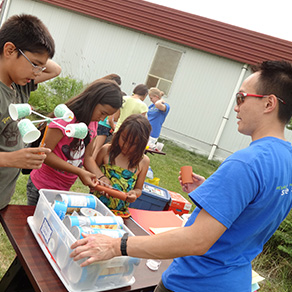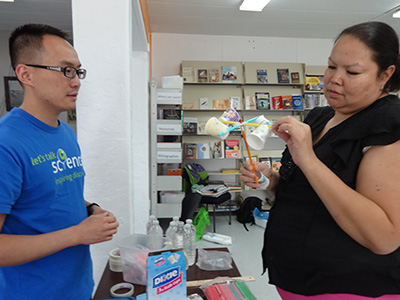Our Stories: Honouring Cultures and Inspiring Strong Futures
Eager faces full of wonderment peer with anticipation into the mesh basket in the middle of the table. Inside, a butterfly is about to emerge from its chrysalis before a mesmerized audience of Grade Two students. Manisha Khetarpal warmly explains, “There is absolute silence as they wait for this miracle of nature.”
Manisha and these young students belong to the Four Nations of Maskwacis (Bear Hills) Cree — Alberta’s largest indigenous community whose home is the area known as Maskwacis and Pigeon Lake, about an hour’s drive south of Edmonton.
They’re gathered in the library of the Maskwacis Cultural College, where Manisha works as the Community College Program Organizer. She is also the one who led the charge to invite Let’s Talk Science’s Outreach Program with free hands-on activities using science, technology, engineering and math (STEM). Together, they are inspiring discovery, creativity and collaboration among her community’s youth.
A Passion for Learning
Respecting the Elders of the Maskwacis, the college focuses its education and training to assist students in their lifelong efforts to reach harmony with the environment, self and others. When Manisha first heard about Let’s Talk Science in 2012, she recognized the alignment between her college’s mission and approach — to facilitate an enhanced quality of life for her community — and that of Let’s Talk Science, to motivate and empower youth to fulfil their potential.
The collaboration of like minds is making a difference. “Let’s Talk Science has enabled us to link what they teach with our curriculum,” explains Manisha. “I have seen a real change since they first joined us. We have all learned to experiment and spend more time exploring and honouring each others’ cultures.”
The Sharing Circle Widens
William Chan has visited the Cree of Maskwacis six times over a one-and-a-half year period. He says each visit is unique and special. William is the Let’s Talk Science Outreach Site Coordinator at the University of Alberta, as well as one of 3,500 volunteers who delivers Let’s Talk Science’s programs in urban, rural and remote communities across Canada. Like his fellow volunteers who are undergrad and graduate students in STEM disciplines, William also serves as an important role model for youth to pursue STEM learning.
“Science can be a channel through which one experiences self-discovery, develops self-identity, and acquires self-confidence and self-esteem,” says William.
During his last visit in June of 2014, William was honoured to take part in the college’s Sharing Circles to learn about the values, beliefs and traditions of the Cree of Maskwacis and build relationships within the community.
To begin the Sharing Circle, each member states the purpose of their presence. “I described my role as a Let’s Talk Science volunteer and sought answers as to how our group could help Maskwacis,” explains William.
Respecting and learning more about the First Nations, Métis and Inuit communities are key steps to fulfilling Let’s Talk Science’s deep commitment to ensuring equitable access to its programs, which are often adapted to be interest-based and culturally relevant for youth of all ages.
“Members of this community, from the very young to the very old, learn that science education can be fun and that there are meaningful careers in this field that will help shape the future of our community,” explains Manisha. “Our people learn that they can become landscape artists or technicians, engineers or environmental stewards. We must all work together to make Canada a great place,” she adds.
Cultivating Community Strength through Discovery
William recounts students’ delight in learning about science with other Outreach volunteers on one of Let’s Talk Science’s visits with the Maskwacis.
“Four of us visited 100 children from the community on a beautiful sunny day,” recalls William. “Together we made DNA models out of licorice, Jujubes and toothpicks, and anemometers out of drinking straws, cups and pencils to measure wind speed. The children played with homemade pinhole cameras to learn about light. We also examined cross-sections of tree trunks, known as tree cookies, to discover clues about the tree’s growth and climate conditions during its life.”
One young boy waited patiently to speak with William after an experiment to create and launch rockets with Alka Seltzer tablets, test tubes and water. Working in two teams of 10, he was among the students who collaborated with each other to build simple rockets. Together, they enjoyed some friendly competition to see whose rocket would go the farthest. “He had so many questions: ‘How could I do this at home? How could I modify the rocket to be even better?’” recalled William, who happily shared more rocket building tips and materials with the curious young boy.
“Children are natural explorers. Discovery through hands-on science is a wonderful way for them to learn because it honours their inclination to explore,” remarks William. “This is what I most want to do as a volunteer — make a difference and create positive change.”
For the Cree of Maskwacis, the change is one of renewed hope, strength and vision toward “possible future goals for our citizens,” Manisha remarks with enthusiasm.
Donate now to Let’s Talk Science and give the gifts of critical thinking, problem-solving, creativity and collaboration to children and youth across Canada through free educational programs, including Let’s Talk Science Outreach.

